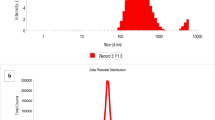Abstract
The aim of the present study is to increase the saturation solubility and oral bioavailability of olmesartan medoxomil (OLM) using nano-sized crystals produced using a combination of antisolvent precipitation and high-shear homogenization. A response surface design comprising 46 runs was used to optimize the OLM nanocrystal formulation. The optimized formulation was produced using a combination of d-alpha tocopheryl polyethylene glycol 1000 succinate (TPGS) (0.7% w/v), Pluronic F-68® (0.5% w/v), and drug concentration (0.2% w/v) and subjected to 10 and 15 homogenization cycles at 1000 and 1700 bar, respectively. The particle size, polydispersity index (PDI), and zeta potential of optimized formulation were found to be 140 ± 10.34 nm, 0.07 ± 0.016, and −21.43 ± 2.33 mV, respectively. The optimized formulation exhibited irregular morphology as evaluated by scanning electron microscopy and was crystalline as determined by thermal analysis and powder X-ray diffraction studies. OLM nanocrystals showed a marked increase in the saturation solubility as well as rapid dissolution rate in comparison with the pure drug. No significant change in the particle size, PDI, and zeta potential was observed when optimized formulation was stored at room and refrigeration conditions for 3 months. Lastly, in vivo pharmacokinetic studies in Sprague-Dawley rats substantiate the ability of OLM nanocrystal formulation to significantly improve (∼4.6-fold) the oral bioavailability of OLM in comparison with the free drug. This study has established a potential and commercial viable OLM formulation with enhanced saturation solubility and in vivo oral bioavailability.







Similar content being viewed by others
References
Moschwitzer JP. Drug nanocrystals in the commercial pharmaceutical development process. Int J Pharm. 2013;453(1):142–56.
Muller RH, Keck CM. Twenty years of drug nanocrystals: where are we, and where do we go? Eur J Pharm Biopharm. 2012;80(1):1–3.
Sinha B, Muller RH, Moschwitzer JP. Bottom-up approaches for preparing drug nanocrystals: formulations and factors affecting particle size. Int J Pharm. 2013;453(1):126–41.
Salazar J, Ghanem A, Muller RH, Moschwitzer JP. Nanocrystals: comparison of the size reduction effectiveness of a novel combinative method with conventional top-down approaches. Eur J Pharm Biopharm. 2012;81(1):82–90.
Moschwitzer J, Muller RH. New method for the effective production of ultrafine drug nanocrystals. J Nanosci Nanotechnol. 2006;6(9–10):3145–53.
Zhu JR, Zhang SY, Gao PJ. Efficacy and safety of olmesartan medoxomil/amlodipine fixed-dose combination for hypertensive patients uncontrolled with monotherapy. Arch Pharm Res. 2014;37(12):1588–98.
Brunner HR. The new oral angiotensin II antagonist olmesartan medoxomil: a concise overview. J Hum Hypertens. 2002;16(Suppl 2):S13–6.
Thakkar HP, Patel BV, Thakkar SP. Development and characterization of nanosuspensions of olmesartan medoxomil for bioavailability enhancement. J Pharm Bioallied Sci. 2011;3(3):426–34.
Attari Z, Bhandari A, Jagadish P, Lewis S. Enhanced ex vivo intestinal absorption of olmesartan medoxomil nanosuspension: preparation by combinative technology. Saudi Pharmaceutical Journal. 2016;24(1):57–63.
Jain S, Sharma JM, Jain AK, Mahajan RR. Surface-stabilized lopinavir nanoparticles enhance oral bioavailability without coadministration of ritonavir. Nanomedicine. 2013;8(10):1639–55.
Jain S, Sharma JM, Agrawal AK, Mahajan RR. Surface stabilized efavirenz nanoparticles for oral bioavailability enhancement. J Biomed Nanotechnol. 2013;9(11):1862–74.
Merisko-Liversidge E, Liversidge GG. Nanosizing for oral and parenteral drug delivery: a perspective on formulating poorly-water soluble compounds using wet media milling technology. Adv Drug Deliv Rev. 2011;63(6):427–40.
Jain S, Rathi VV, Jain AK, Das M, Godugu C. Folate-decorated PLGA nanoparticles as a rationally designed vehicle for the oral delivery of insulin. Nanomedicine. 2012;7(9):1311–37.
Yanni S, Thakker DR. Prodrugs: absorption, distribution, metabolism, excretion (ADME) issues. Prodrugs. Springer; 2007. p. 1043–81.
Van Eerdenbrugh B, Vermant J, Martens JA, Froyen L, Van Humbeeck J, Augustijns P, et al. A screening study of surface stabilization during the production of drug nanocrystals. J Pharm Sci. 2009;98(6):2091–103.
Harde H, Agrawal AK, Jain S. Trilateral ‘3P’ mechanics of stabilized layersomes technology for efficient oral immunization. J Biomed Nanotechnol. 2015;11(3):363–81.
Shchekin AK, Rusanov AI. Generalization of the Gibbs-Kelvin-Kohler and Ostwald-Freundlich equations for a liquid film on a soluble nanoparticle. J Chem Phys. 2008;129(15):154116.
Mller RH, Akkar A. Drug nanocrystals of poorly soluble drugs. Encyclopedia of nanoscience and nanotechnology. vol 638: American Scientific Publishers; 2004. p. 627–38.
Galli C. Experimental determination of the diffusion boundary layer width of micron and submicron particles. Int J Pharm. 2006;313(1–2):114–22.
Mosharraf M, Nyström C. The effect of particle size and shape on the surface specific dissolution rate of microsized practically insoluble drugs. Int J Pharm. 1995;122(1):35–47.
Hasegawa Y, Higashi K, Yamamoto K, Moribe K. Direct evaluation of molecular states of piroxicam/poloxamer nanosuspension by suspended-state NMR and Raman spectroscopies. Mol Pharm. 2015;12(5):1564–72.
Wei CC, Ge ZQ. Influence of electrolyte and poloxamer 188 on the aggregation kinetics of solid lipid nanoparticles (SLNs). Drug Dev Ind Pharm. 2012;38(9):1084–9.
Ahuja BK, Jena SK, Paidi SK, Bagri S, Suresh S. Formulation, optimization and in vitro-in vivo evaluation of febuxostat nanosuspension. Int J Pharm. 2015;478(2):540–52.
Cai Z, Wang Y, Zhu LJ, Liu ZQ. Nanocarriers: a general strategy for enhancement of oral bioavailability of poorly absorbed or pre-systemically metabolized drugs. Curr Drug Metab. 2010;11(2):197–207.
Acknowledgements
The authors are thankful to the director, NIPER, for providing necessary infrastructure facilities. The authors also thank Rahul R. Mahajan for providing technical assistance with scanning electron microscopy.
Author information
Authors and Affiliations
Corresponding author
Ethics declarations
All animal experiments were carried out under the guidelines compiled by the Committee for the Purpose of Control and Supervision of Experiments on Animals ((CPCSEA), Ministry of Environment, Forests and Climate Change, Govt. of India), and all the study protocols were duly approved by the Institutional Animal Ethics Committee of NIPER, S.A.S., India, before the start of the study
Conflict of interest
The authors declare that they have no conflicts of interest.
Electronic supplementary material
ESM 1
(DOCX 3579 kb)
Rights and permissions
About this article
Cite this article
Jain, S., Patel, K., Arora, S. et al. Formulation, optimization, and in vitro–in vivo evaluation of olmesartan medoxomil nanocrystals. Drug Deliv. and Transl. Res. 7, 292–303 (2017). https://doi.org/10.1007/s13346-016-0355-2
Published:
Issue Date:
DOI: https://doi.org/10.1007/s13346-016-0355-2




